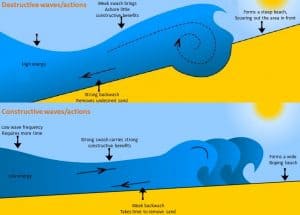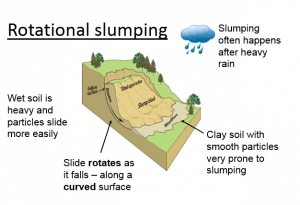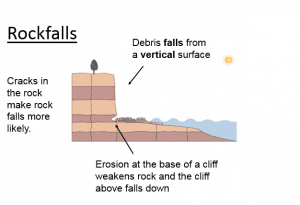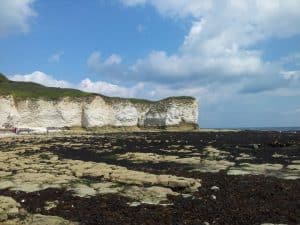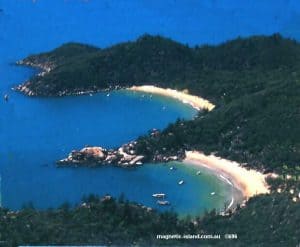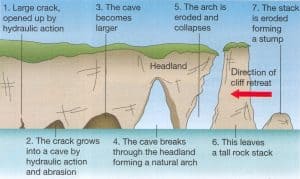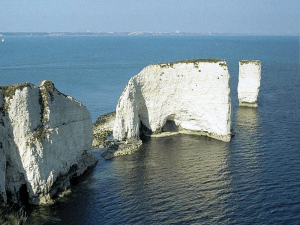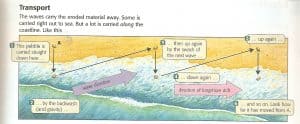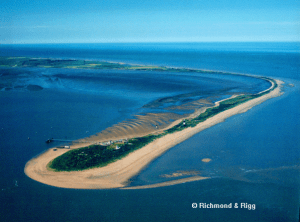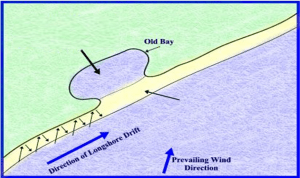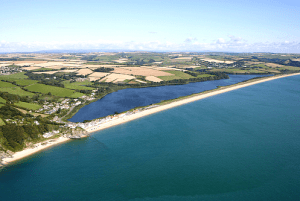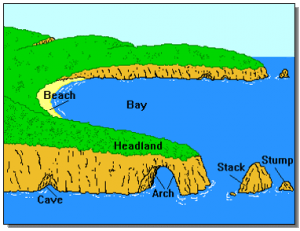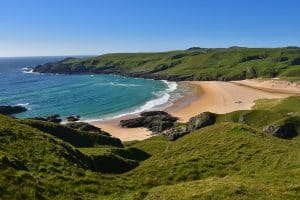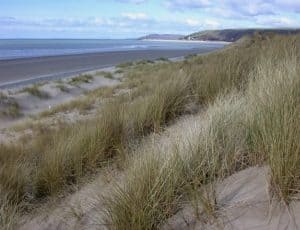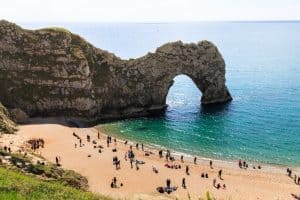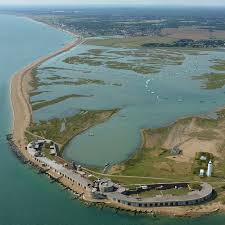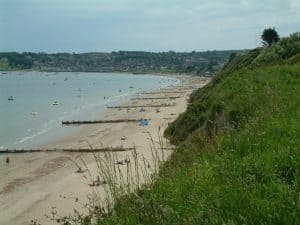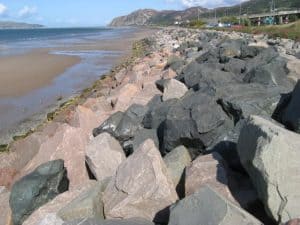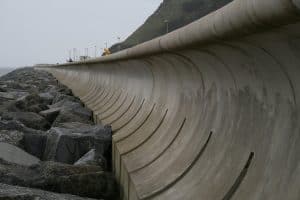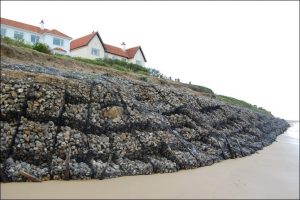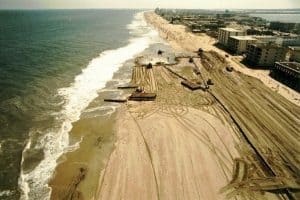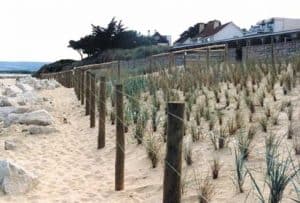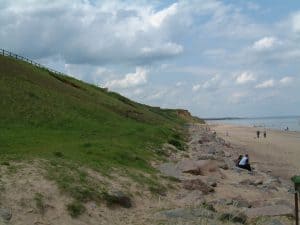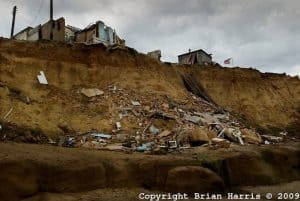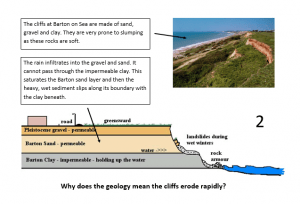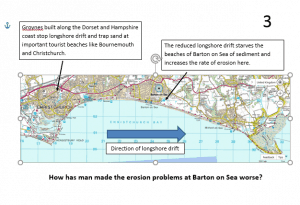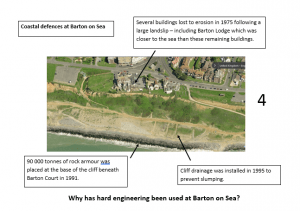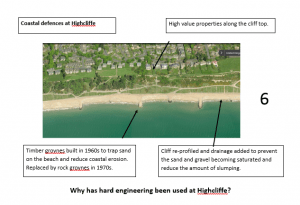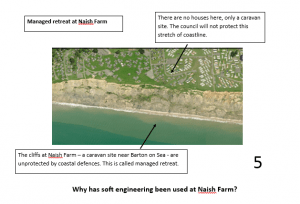Wave
A wave is formed by wind blowing over the surface of a sea or ocean. There is friction between the wind and the water and this starts up a wave motion.
As a wave gets closer to the coast it gets taller. This is because the base of the wave slows down due to friction with the sea bed. The top of the wave carries on at the same speed. The wave breaks and water rushes up the beach. This is called the swash. Water runs back down to the sea. This is the backwash.
The fetch is the distance of sea or ocean over which the wind blows. The bigger the fetch (meaning bigger sea or ocean) the bigger the wave.
Types of wave
Destructive waves occur frequently – 10 times per minute. They have a weak swash and strong backwash. They erode material from the coast leaving a steeply sloping beach.
Constructive waves occur less frequently – 6-8 times per minute. They have a strong swash and weak backwash. They deposit material from the coast leaving a gently sloping beach.
Coastal processes
There are 4 types of weathering
- Freeze-thaw weathering
- Biolgogical weathering
- Chemical weathering
- Onion skin weathering
There are 4 types of erosion
- Abrasion (sometimes called corrasion)
- Hydraulic action
- Attrition
- Corrosion (sometimes called solution)
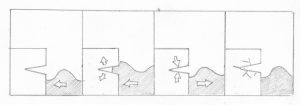 All these coastal process work in the same way as they do in rivers. The one exception is hydraulic action. Here air in a crack is compressed by a wave rushing in. This increases pressure in the crack. The wave retreats and the pressure is released. This repeated pressure-release leads to the rock being weakened, broken and carried away.
All these coastal process work in the same way as they do in rivers. The one exception is hydraulic action. Here air in a crack is compressed by a wave rushing in. This increases pressure in the crack. The wave retreats and the pressure is released. This repeated pressure-release leads to the rock being weakened, broken and carried away.
There are 3 types of mass movement
Coastal features formed by erosion
Wave cut platforms
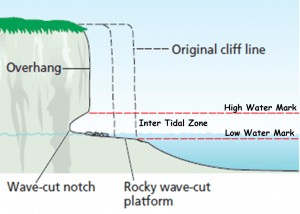 A wave cut platform occurs where a cliff has been eroded and retreats. Hydraulic action and abrasion occurs at the base of the cliff where the wave hits the rock. A wave cut notch is formed. This gets bigger until the cliff collapses and retreats leaving behind a wave cut platform.
A wave cut platform occurs where a cliff has been eroded and retreats. Hydraulic action and abrasion occurs at the base of the cliff where the wave hits the rock. A wave cut notch is formed. This gets bigger until the cliff collapses and retreats leaving behind a wave cut platform.
A wave cut platform
Headlands and bays
Headlands and bays form where different layers of rock meet the sea. Soft rock such as clay is easy to erode so forms a bay. Hard rock is more resistant to erosion sois left sticking out to sea forming a headland.
Different rock types can be refered to as geology.
Headlands and bays
Caves, arches, stacks and stumps
A cave forms in a headland due to erosion by abrasion and hydraulic action. The cave gets bigger until it erodes right through the headland to form an arch. The arch gets bigger until the roof collapses leaving a stack. Eventually the stack will collapse leaving a stump.
Caves, Arches and Stacks
Coastal transport
A wave approaches the beach at a angle driven by the prevailing wind. The swash from the wave carries material up the beach at an angle too. The backwash carries the material straight back down the beach due to gravity. Over time material is moved along the beach. This is called longshore drift.
Coastal features formed by deposition
Spits
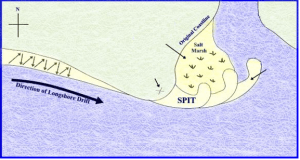 A spit is formed by longshore drift transporting material along the coast. It reaches a headland or change of direction. The prevailing wind means that longshore drift does not turn the corner. Instead material is deposited. Over time this builds out to sea forming a spit. Winds blowing from different direction create a curved end. Behind a spit forms a salt marsh.
A spit is formed by longshore drift transporting material along the coast. It reaches a headland or change of direction. The prevailing wind means that longshore drift does not turn the corner. Instead material is deposited. Over time this builds out to sea forming a spit. Winds blowing from different direction create a curved end. Behind a spit forms a salt marsh.
A spit
Bars
A bar is formed when longshore drift transports material along the coast, just like the process above. Here material is deposited right across a bay. A lagoon is formed behind the bar.
A bar
Beaches
A bay head beach is formed by deposition. Material is eroded from nearby coasts, including headlands. It is ground up by attrition. Constructive waves deposit this material as sand in a bay.
A bay head beach
Sand dunes
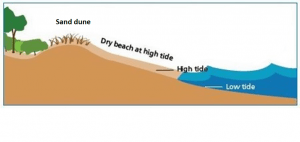 A sand dune is formed inland from a beach. When the sand dries out at low tide, the wind blows it up the beach. The sand is deposited around obstacles such as plants. Marram grass grows and its roots hold the sand dunes together.
A sand dune is formed inland from a beach. When the sand dries out at low tide, the wind blows it up the beach. The sand is deposited around obstacles such as plants. Marram grass grows and its roots hold the sand dunes together.
A sand dune.
UK coastline example
 The Jurassic Coast is a world heritage site in Dorest, UK
The Jurassic Coast is a world heritage site in Dorest, UK
The Jurassic Coast has bays such as Lulworth Cove.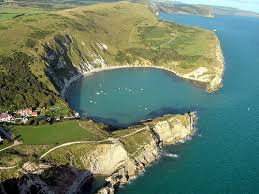
There are arches like Durdle Door.
There are headlands like Perveril Point (foreground) and stacks like Old Harry (back ground).
and stacks like Old Harry (back ground).
There are spits such as Hurst Point.
There is even a tombolo (a spit which joins a island to the mainland) 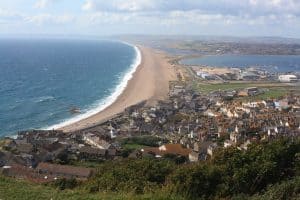 called Chesil Beach.
called Chesil Beach.
Factors affecting coastal recession
Cliff recession (the rate of cliff erosion) can be as high as 2m in Yorkshire and 1cm in Cornwall.
The rate of recession is affected by geology, fetch and defences.
- Fetch – the larger the fetch, the greater the rate of erosion.
- Geology – soft rock erodes faster than hard rock, rock with cracks and joints erodes faster than rock without, rock with cracks sloping towards the sea erodes faster than rock with cracks sloping inland.
- Defences – cliffs without protection by defences erode faster than those cliffs with defences.
Coastal defences
Groynes
Groynes are wooden barriers that stop sand being moved along the coast by longshore drift. This traps the sand and makes the beach bigger. As a result the waves break further from the cliff reducing erosion.
Rock Armour
Rock armour is large granite boulders are placed at the bottom of a cliff to absorb the energy of the waves and reinforce the soft rock of the coast.
Sea Wall
Sea walls are concrete reinforcements for a rapidly eroding cliff. They deflect the waves’ energy back out to sea to reduce the rate of cliff retreat.
Gabions
Gabions are wire cages filled with stones. They absorb the energy of the waves and protect the base of the cliff from erosion.
Beach nourishment
Beach nourishment adds more sand to a beach. The sand is dug up from the sea bed and dropped on the beach. It creates a bigger beach that keeps the eroding waves further from the cliff.
Dune regeneration
Dune regeneration creates new sand dunes along the coast to act as a buffer between the land and the sea. Fences prevent people walking and eroding the dunes. Planting Marram grass holds the sand dune together with plant roots and traps more sand.
Cliff reprofing
Cliff reprofiling works by reducing the angle of the cliff. Adding drainage stops clay cliffs getting saturated and slumping. Adding plants to the slope holds the soil together and reduces coastal recession.
Managed retreat
Managed retreat means Do nothing. Let the sea erode and move people back from cliffs that are retreating.
Hard engineering – use major construction e.g. groynes, sea walls, rock armour, gabions.
Soft engineering – works with nature e.g beach nourishment, dune regeneration, cliff reprofing, managed retreat.
CASE STUDY
Barton on Sea is a town in Hampshire on the south coast of England.
Reasons for coastal management
The management strategies used at Barton on Sea
Who may be in favour or against?
Some groups of people will be in favour of coastal defences at Barton on Sea. They include the owners of Naish Farm Caravan site, which is currently unprotected. Home owners and estate agents in Barton on Sea will like the hard engineering defences to protect property. Tourists will like the larger beach created by the groynes.
However, other people will be against coastal defences at Barton on Sea. People living along the coast at Hurst Spit will not like groynes trapping all the sand at Barton. Taxpayers may not like the cost of the project. Fossil hunters may object to the cliffs not eroding and exposing fossils.

